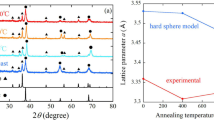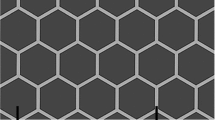Abstract
The current-voltage characteristics of the metal-dielectric composite have been investigated in the range of the resistive state near the superconducting transition temperature T c . The composite structure can be represented as a face-centered cubic lattice, which involves a large number of weakly linked indium nanograins and is stabilized in structural cavities of opal. The response to microwave radiation is used to characterize the resistive state of the composite. The comparative investigation into the current-voltage characteristics and the response of the composite to microwave radiation makes it possible to conclude that the weak links are superconducting in the region of critical current (I c ) of the composite as a whole. The transition of weak links to the resistive state occurs at currents immediately preceding the transition of the composite from the resistive state to the ohmic state. The model of resistivity of the indium-opal composite is proposed on the basis of morphological examinations. According to this model, the energy dissipation in the resistive state is brought about by the quasi-discrete (due to the quantization of the magnetic flux in circuits of a three-dimensional lattice comprised of multiply connected grains) redistribution of transport current over the cross-section of composite.
Similar content being viewed by others
References
S. G. Romanov and C. M. Sotomayor Torres, in Handbook of Nanostructural Materials and Nanotechnology, Ed. by H. S. Halwa (Academic Press, 1999), Vol. 4, pp. 231–323.
H.-T. S. Lihn and H. D. Drew, Phys. Rev. B 56, 5559 (1997).
R. Escudero and H. J. T. Smith, Phys. Rev. B 31, 2725 (1985); T. Kommers and J. Clark, Phys. Rev. Lett. 38, 1091 (1977); T. M. Klapwijk and J. E. Mooij, Physica B (Amsterdam) 81, 132 (1976); P. M. Th. M. van Attekum and J. J. Ramekers, Solid State Commun. 43, 735 (1982); J. E. Mooij and T. M. Klapwijk, Phys. Rev. B 27, 3054 (1983); D. R. McIntosh and J. Lindesay, Phys. Rev. B 50, 15852 (1994).
R. Kleiner and P. Muller, Phys. Rev. B 49, 1327 (1994).
S. P. Benz and C. J. Burroughs, Appl. Phys. Lett. 58, 2162 (1991).
A. K. Jain, K. K. Likharev, J. E. Lukens, et al., Phys. Rep. 109, 309 (1984).
S. G. Lachenmann, T. Doderer, D. Hoffmann, et al., Phys. Rev. B 50, 3158 (1994).
V. N. Bogomolov, Usp. Fiz. Nauk 124, 77 (1972).
V. N. Bogomolov, V. V. Zhuravlev, A. I. Zadorozhnyi, et al., Pis’ma Zh. Éksp. Teor. Fiz. 36, 298 (1982) [JETP Lett. 36, 365 (1982)].
V. N. Bogomolov, Y. A. Kumzerov, S. G. Romanov, et al., Physica C (Amsterdam) 208, 371 (1993).
S. G. Romanov, Pis’ma Zh. Éksp. Teor. Fiz. 59, 778 (1994) [JETP Lett. 59, 809 (1994)].
V. G. Balakirev, V. N. Bogomolov, V. V. Zhuravlev, et al., Kristallografiya 38, 111 (1993) [Crystallogr. Rep. 38, 348 (1993)].
V. V. Tretyakov, S. G. Romanov, A. V. Fokin, et al., Mikrochim. Acta, No. S15, 211 (1998).
V. N. Bogomolov, L. M. Sorokin, D. A. Kurdyukov, et al., Fiz. Tverd. Tela (S.-Peterburg) 39, 2090 (1997) [Phys. Solid State 39, 1869 (1997)].
H. T. Vogel and M. M. Garland, J. Appl. Phys. 38, 5116 (1967).
K. Kh. Babamuratov, V. V. Zhuravlev, Yu. A. Kumzerov, et al., Fiz. Tverd. Tela (Leningrad) 35, 1577 (1993) [Phys. Solid State 35, 795 (1993)].
K. K. Likharev, Rev. Mod. Phys. 51, 101 (1979).
P. Martinoli, Phys. Rev. B 17, 1175 (1978).
S. G. Lachenmann, T. Doderer, R. P. Huebener, et al., Phys. Rev. B 56, 5564 (1997).
I. O. Kulik and A. N. Omel’yanchuk, Fiz. Nizk. Temp. (Kiev) 3, 945 (1977) [Sov. J. Low Temp. Phys. 3, 459 (1977)].
T. M. Klapwijk, G. E. Blonder, and M. Tinkham, Physica B + C (Amsterdam) 109–110, 1657 (1982).
J. E. Mooij and P. Dekker, J. Low Temp. Phys. 33, 551 (1978).
S. G. Romanov, in Critical Currents in Superconductors, Ed. by H. W. Weber (World Scientific, 1994), p. 473.
S. G. Romanov, A. V. Fokin, and K. Kh. Babamuratov, Pis’ma Zh. Éksp. Teor. Fiz. 58, 883 (1993) [JETP Lett. 58, 824 (1993)].
E. C. Babaev and S. A Ktitorov, Phys. Solid State 39, 1024 (1997).
J. A. Pals and J. Dobben, Phys. Rev. Lett. 44, 1143 (1980).
Author information
Authors and Affiliations
Additional information
__________
Translated from Fizika Tverdogo Tela, Vol. 42, No. 4, 2000, pp. 581–588.
Original Russian Text Copyright © 2000 by Romanov, Shamshur.
Rights and permissions
About this article
Cite this article
Romanov, S.G., Shamshur, D.V. Current-induced suppression of superconductivity in a three-dimensional lattice of weakly linked indium grains in opal. Phys. Solid State 42, 594–602 (2000). https://doi.org/10.1134/1.1131255
Received:
Issue Date:
DOI: https://doi.org/10.1134/1.1131255




